Electric Trucks in India: The Future of Transportation
1. Introduction
India is changing how it moves things around. Electric vehicles (EVs) are a big part of this change. India buys more cars and trucks than most other countries. Now, it's starting to use more electric vehicles, especially electric trucks. This is good for making money and helping the environment. Electric trucks in India are becoming more common. They're not just an idea for the future - they're here now and changing how we move goods. EV trucks can help cut down on pollution and save money for truck owners. They're also helping solve some of the problems that Indian trucking companies face. As more electric trucks hit Indian roads, they're making a big difference in how the country transports goods.
2. Current State of the Trucking Industry in India
2.1 Market Size and Economic Impact
- ndia ranks as the world's 3rd largest automotive market
- The automotive industry contributes 7.1% to India's GDP
- India is the 6th largest market globally for medium and heavy-duty trucks (MHDTs)
- In 2021, over 200,000 MHDTs were sold in India
- More than 5 million trucks currently operate on Indian roads
2.2 Environmental Impact
- The transport sector is responsible for nearly 14% of India's total greenhouse gas emissions
- Road transport accounts for over 90% of these emissions
- Trucks represent only 2% of road vehicles by volume but are responsible for over 40% of road transport emissions and fuel consumption
- Over 90% of trucks in India use diesel, a major source of NOx emissions
2.3 Current EV Adoption
- EVs currently account for about 2% of total car sales in India
- The domestic EV market is projected to grow at a CAGR of 49% between 2022 and 2030
3. Why Electric Trucks matter for India
3.1 Environmental Benefits
- Significant reduction in greenhouse gas emissions
- Decrease in local air pollution and noise pollution
- Contribution to global efforts to achieve net zero emissions
3.2 Economic Advantages
- Reduced operating costs due to lower fuel and maintenance expenses
- Potential for job creation in the EV industry (projected 50 million direct and indirect jobs by 2030)
- Boost to the domestic manufacturing sector
3.3 Energy Security
- Reduced dependence on imported fossil fuels
- Integration with renewable energy sources for charging
4. Government Policies related to EVs in Trucking Industry
4.1 National Targets
- 30% electrification of the vehicle fleet by 2030
- Electric trucks to constitute at least 8% of all freight trucks by 2070 to achieve net zero emissions
4.2 Financial Incentives
- Union Budget 2023-24: Allocation of INR 350 billion for energy transition and net zero emissions
- FAME-II program: Budget allocation of INR 5,172 crore (approximately $631 million)
- Production Linked Incentive (PLI) Scheme for the automotive sector
4.3 Infrastructure Development
- Support for a 4,000 MWH capacity battery storage system through the Viability Gap Fund
- Development of charging infrastructure across the country
5. Market Projections and Growth Forecasts in india
5.1 Overall EV Market
- EV sales expected to grow by 40-45% by 2030
- Projected annual sales of 13 million new EVs by 2030
- Domestic EV market to reach 10 million units in annual sales by 2030
5.2 Commercial Vehicle Segment
- Light trucks: 20-25% adoption rate by 2030, reaching around 930,000 vehicles
- Buses: 15-20% adoption rate by 2030, with approximately 175,000 electric buses
- Four-wheeler segment (including trucks): 15-20% growth by 2030, with one million new vehicles sold annually
5.3 Road Logistics Market
- Expected to grow at a CAGR of 8% over the next three years
- Projected to reach $330 billion by 2025
6. Top Electric Trucks in India
6.1 Light Commercial Vehicles (LCVs):

Tata Ace EV
The Tata Ace EV is perfect for last-mile delivery and urban logistics, being the smallest in this lineup.
| Specification | Details |
| Range | 154 km/charge |
| Payload Capacity | 600 KG |
| Charging Time | 6-7 Hours |
| GVW | 1840 kg |
| No. of Tyres | 4 |
| Price | ₹ 9.21 – 9.22 Lakh |
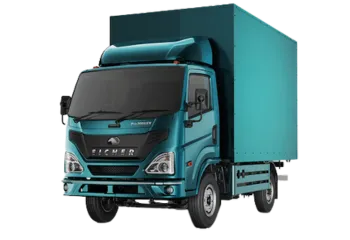
Eicher Pro 2055 Electric
Slightly larger than the Ace EV, the Eicher Pro 2055 Electric is designed for efficient city operations.
Specification | Details |
Payload Capacity | 2209 KG |
GVW | 5450 kg |
No. of Tyres | 4 |
Battery Capacity | 64.4 Kwh |
Charging Time | 8-10 Hours |
6.2 Intermediate Commercial Vehicles (ICVs):
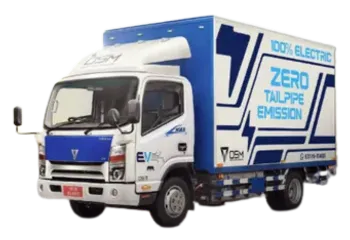
OSM M1KA 3.0
The OSM M1KA 3.0 bridges the gap between light and medium-duty trucks.
Specification | Details |
Engine Norm | Zero Tailpipe |
Max Torque | 415 NM |
Max Speed | 90 kmph |
No. of Tyres | 6 |
GVW | 5500 kg |
Motor Type | Permanent Magnet Synchronous |
Kerb Weight | 3055 kg |
Range | 180 km Per Charge |
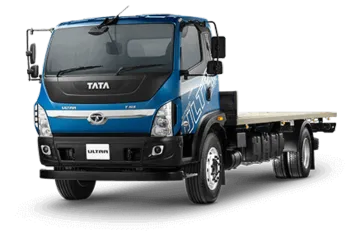
Tata Ultra T.7 Electric
The Tata Ultra T.7 Electric is India’s first electric intermediate commercial vehicle.
Specification | Details |
Range | 100 km/charge |
Payload Capacity | 3692 – 4935 KG |
Charging Time | 2 hours (Approx) |
GVW | 7490 – 8750 kg |
No. of Tyres | 6 |
Price | ₹ 15.29 – 16.81 Lakh |
6.3 Medium Duty Trucks:
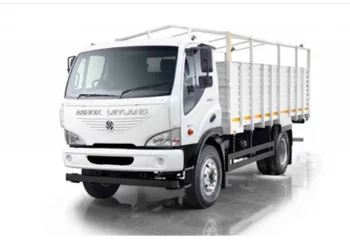
Ashok Leyland Boss 1219 EV Truck
The Ashok Leyland Boss 1219 EV is designed for versatile medium-duty logistics operations.
Specification | Details |
Payload Capacity | 6000 KG |
GVW | 11990 kg |
No. of Tyres | 6 |
Max Speed | 80 KMPH |
6.4 Heavy Duty Trucks:
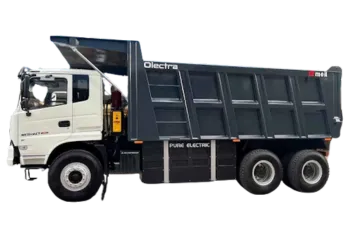
Olectra Electric Truck
The Olectra Electric Truck is a heavy-duty electric tipper truck for construction and mining applications.
Specification | Details |
Range | 70-110 Km/charge |
GVW | 28000 kg |
No. of Tyres | 10 |
Max Speed | 80 KMPH |
Charging Time | 2 Hours |
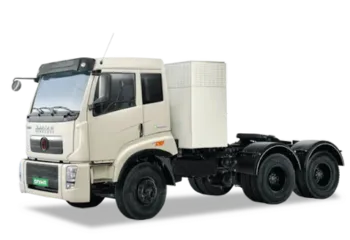
Rhino Electric Heavy-Duty Truck
The Rhino is the largest and most powerful electric truck in this lineup, designed for long-haul transportation.
Specification | Details |
GCW | 55000 kgs |
Maximum Power | 360 HP @ 1200 r/min |
Torque | 2400 Nm @ 600 r/min |
Range | 185 kms (under standard conditions) |
Battery | 258 kWh LFP |
Charging Time | 90 mins (SOC 20 – 100%) |
Transmission | 12-Speed AMT |
7. Advantages of Electric Trucks
7.1 Lower Operating Costs
- Reduced fuel expenses compared to diesel trucks
- Lower maintenance costs due to fewer moving parts
7.2 Improved Performance
- Better torque characteristics for improved acceleration and hill-climbing ability
- Quieter operation, beneficial for urban deliveries
7.3 Compliance with Emission Norms
- Help fleet operators meet increasingly stringent emission standards
- Potential for entering low-emission zones in cities1
8. Challenges in Electric Truck Adoption
8.1 Limited Model Availability
- Insufficient e-truck models for heavier transport sectors
- Need for more diverse options to cater to various logistics needs
8.2 High Upfront Costs
- Electric trucks currently have higher purchase prices compared to diesel counterparts
- Need for financial incentives and innovative financing models to offset initial costs
8.3 Range Anxiety and Charging Infrastructure
- Concerns about long-distance travel capabilities
- Insufficient charging infrastructure for long-haul operations
- Need for strategic placement of fast-charging stations along major trucking routes
8.4 Battery Technology Limitations
- Current battery technology may not be optimal for heavy-duty long-haul operations
- Ongoing research and development required for more efficient and lighter batteries
9. Strategies for Overcoming Challenges of EVs
9.1 Policy and Regulatory Measures
- Implementation of stringent emission norms to encourage EV adoption
- Introduction of carbon pricing mechanisms to reflect the true cost of fossil fuel use
- Development of standardized charging protocols for interoperability
9.2 Financial Incentives
- Continuation and expansion of subsidies for electric truck purchases
- Tax benefits for fleet operators transitioning to electric trucks
- Low-interest loans and accelerated depreciation for EV investments
9.3 Infrastructure Development
- Public-private partnerships for charging infrastructure deployment
- Integration of renewable energy sources with charging stations
- Development of battery swapping networks for quicker turnaround times
9.4 Research and Development
- Government support for indigenous battery technology development
- Collaboration between academia and industry for innovation in EV powertrains
- Focus on lightweight materials and aerodynamic designs for improved efficiency
10. Industry Initiatives and Corporate Commitment
10.1 Fleet Electrification Programs
- Major logistics companies setting targets for electric truck adoption
- Corporations' commitments to fleet transition enhancing e-truck demand
10.2 Pilot Projects and Use Cases
- Implementation of electric trucks in specific routes and applications
- Showcasing successful use cases to build confidence in the technology
10.3 Global Campaigns and Initiatives
- EV100+ initiative supporting the electrification of medium and heavy-duty freight vehicles by 2040
- Participation of Indian companies in global sustainable transportation alliances
11. Future Prospects and Opportunities
11.1 Technological Advancements
- Development of more efficient electric drivetrains
- Integration of autonomous driving technologies with electric trucks
- Advancements in battery technology for increased range and faster charging
11.2 New Business Models
- Growth of electric truck leasing and subscription services
- Development of specialized maintenance and service networks for electric trucks
- Emergence of electric truck-as-a-service models
11.3 Job Creation and Skill Development
- Estimated 50 million direct and indirect jobs in the EV industry by 2030
- Need for reskilling and upskilling programs for existing workforce
- Development of specialized courses in electric vehicle technology in educational institutions
12. Impact of Electric Trucks on Related Industries
12.1 Energy Sector
- Increased demand for electricity and need for grid upgrades
- Opportunities for renewable energy integration with EV charging
- Development of smart charging solutions and vehicle-to-grid technologies
12.2 Manufacturing Sector
- Growth in domestic production of electric trucks and components
- Potential for India to become a global hub for electric vehicle manufacturing
- Development of a robust supply chain for EV components
12.3 IT and Software Industry
- Opportunities in fleet management software development
- Growth in telematics and connectivity solutions for electric trucks
- Integration of artificial intelligence and machine learning in EV operations
13. Environmental and Social Impact of Electric Trucks
13.1 Emission Reduction
- Significant decrease in CO2 and particulate matter emissions from the trucking sector
- Improvement in air quality, especially in urban areas
- Contribution to India's climate change mitigation efforts
13.2 Noise Pollution Reduction
- Quieter operation of electric trucks benefiting urban environments
- Potential for extended operating hours in noise-sensitive areas
13.3 Health Benefits
- Reduction in respiratory illnesses associated with air pollution
- Improved quality of life for communities near major trucking routes
14. Conclusion
The future of electric trucks in India is promising, with significant potential for growth and positive impact. As the world's third-largest automotive market and sixth-largest market for medium and heavy-duty trucks, India's transition to electric trucks can have far-reaching effects on both the national economy and global sustainability efforts.
Government initiatives, such as the allocation of INR 350 billion for energy transition in the Union Budget 2023-24 and the FAME-II program with a budget of INR 5,172 crore, demonstrate strong support for the EV industry. The target of 30% vehicle fleet electrification by 2030 and the goal of having electric trucks constitute 8% of all freight trucks by 2070 set clear objectives for the industry to work towards.
However, challenges such as high upfront costs, limited model availability, and insufficient charging infrastructure need to be addressed. Strategies including policy support, financial incentives, infrastructure development, and research and development will be crucial in overcoming these hurdles.
The transition to electric trucks offers numerous benefits, including reduced operating costs, improved performance, and significant environmental advantages. With the transport sector responsible for 14% of India's greenhouse gas emissions and trucks accounting for over 40% of road transport emissions despite representing only 2% of vehicles, the shift to electric trucks can have a substantial impact on India's carbon footprint.
As the technology evolves and adoption increases, we can expect to see electric trucks operating even in remote areas of India. This transition will not only lower greenhouse gas emissions but also improve air quality and the overall quality of life for Indian citizens. Moreover, with the potential creation of 50 million direct and indirect jobs in the EV industry by 2030, the economic benefits are substantial.
In conclusion, the future of electric trucks in India is bright, driven by a combination of environmental necessity, economic opportunity, and technological advancement. As the nation progresses towards its sustainability goals, electric trucks will play a pivotal role in shaping a cleaner, more efficient, and economically vibrant transportation sector.

